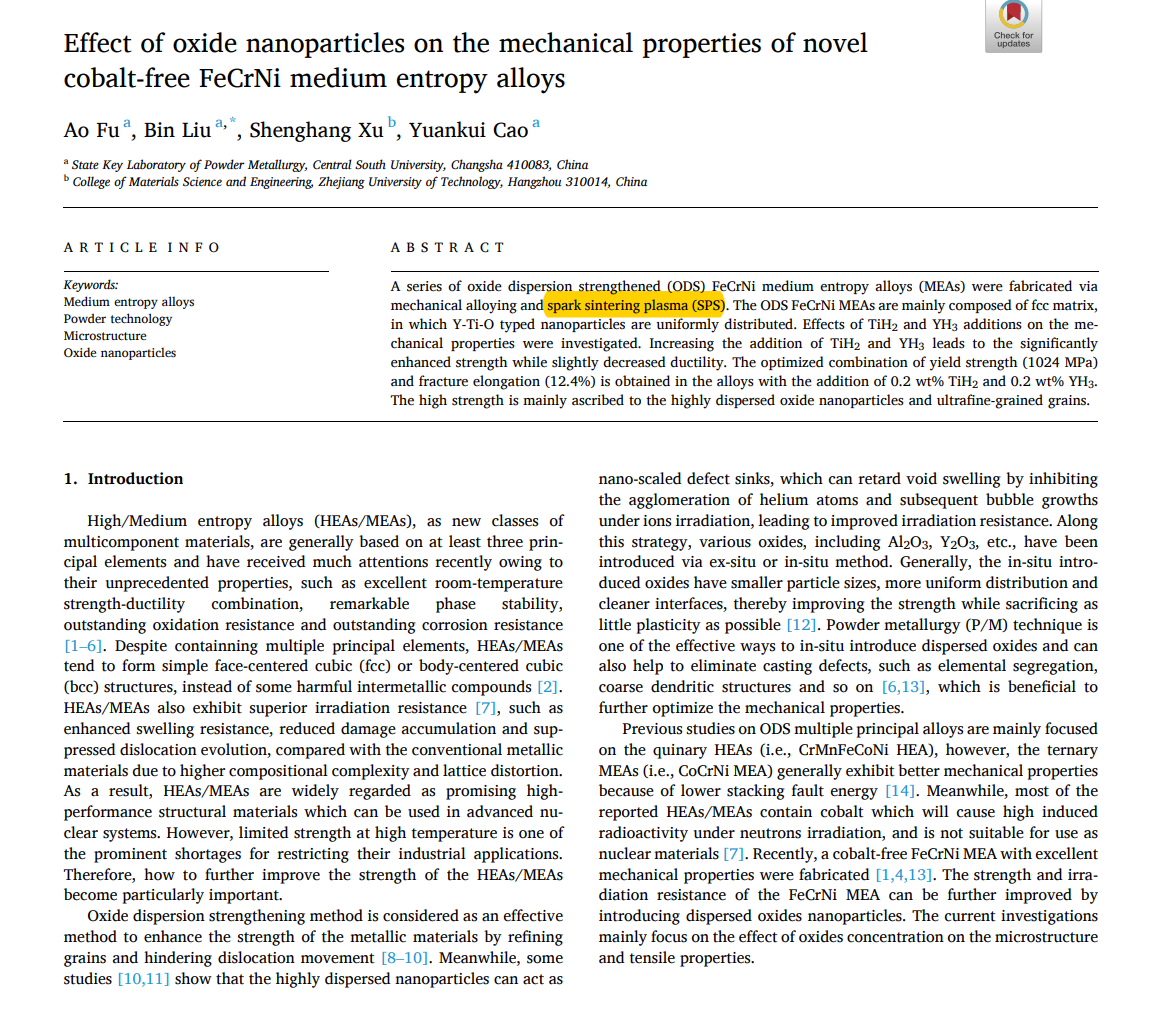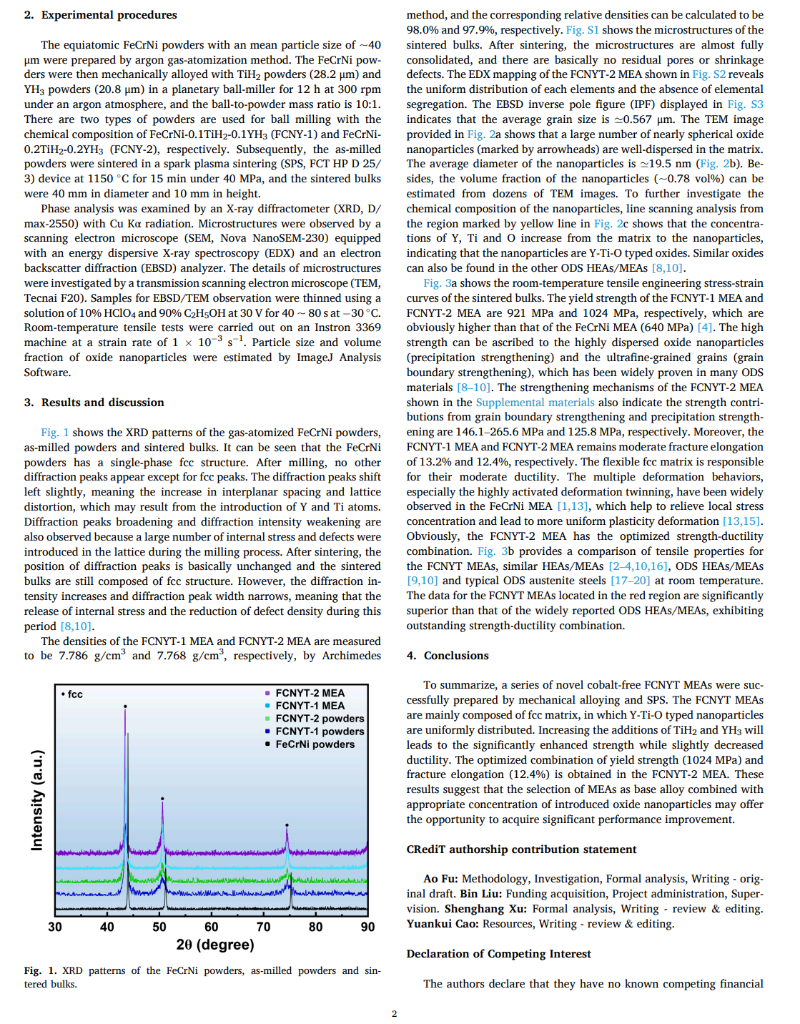Answered step by step
Verified Expert Solution
Question
1 Approved Answer
Summarize this for me someone who perfectly understand it. And make sure the summary is 2 or more paragraphs Effect of oxide nanoparticles on the


Summarize this for me someone who perfectly understand it. And make sure the summary is 2 or more paragraphs
Effect of oxide nanoparticles on the mechanical properties of novel cobalt-free FeCrNi medium entropy alloys Ao Fua, Bin Liu a,", Shenghang Xu b, Yuankui Cao a a State Key Laboratory of Powder Metallurgy, Central South University, Changsha 410083, China b College of Materials Science and Engineering, Zhejiang University of Technology, Hangzhou 310014, China A R T I C L E I N F O A B S T R A C T 1. Introduction nano-scaled defect sinks, which can retard void swelling by inhibiting the agglomeration of helium atoms and subsequent bubble growths High/Medium entropy alloys (HEAs/MEAs), as new classes of under ions irradiation, leading to improved irradiation resistance. Along multicomponent materials, are generally based on at least three prin- this strategy, various oxides, including Al2O3, Y2O3, etc., have been cipal elements and have received much attentions recently owing to introduced via ex-situ or in-situ method. Generally, the in-situ introtheir unprecedented properties, such as excellent room-temperature duced oxides have smaller particle sizes, more uniform distribution and strength-ductility combination, remarkable phase stability, cleaner interfaces, thereby improving the strength while sacrificing as outstanding oxidation resistance and outstanding corrosion resistance little plasticity as possible [12]. Powder metallurgy (P/M) technique is [1-6]. Despite containning multiple principal elements, HEAs/MEAs one of the effective ways to in-situ introduce dispersed oxides and can tend to form simple face-centered cubic (fcc) or body-centered cubic also help to eliminate casting defects, such as elemental segregation, (bcc) structures, instead of some harmful intermetallic compounds [2]. coarse dendritic structures and so on [6,13], which is beneficial to HEAs/MEAs also exhibit superior irradiation resistance [7], such as further optimize the mechanical properties. enhanced swelling resistance, reduced damage accumulation and sup- Previous studies on ODS multiple principal alloys are mainly focused pressed dislocation evolution, compared with the conventional metallic on the quinary HEAs (i.e., CrMnFeCoNi HEA), however, the ternary materials due to higher compositional complexity and lattice distortion. MEAs (i.e., CoCrNi MEA) generally exhibit better mechanical properties As a result, HEAs/MEAs are widely regarded as promising high- because of lower stacking fault energy [14]. Meanwhile, most of the performance structural materials which can be used in advanced nu- reported HEAs/MEAs contain cobalt which will cause high induced clear systems. However, limited strength at high temperature is one of radioactivity under neutrons irradiation, and is not suitable for use the prominent shortages for restricting their industrial applications. nuclear materials [7]. Recently, a cobalt-free FeCrNi MEA with excellent Therefore, how to further improve the strength of the HEAs/MEAs mechanical properties were fabricated [1,4,13]. The strength and irrabecome particularly important. diation resistance of the FeCrNi MEA can be further improved by Oxide dispersion strengthening method is considered as an effective introducing dispersed oxides nanoparticles. The current investigations method to enhance the strength of the metallic materials by refining mainly focus on the effect of oxides concentration on the microstructure grains and hindering dislocation movement [8-10]. Meanwhile, some and tensile properties. studies [10,11] show that the highly dispersed nanoparticles can act as 2. Experimental procedures method, and the corresponding relative densities can be calculated to be 98.0% and 97.9%, respectively. Fig. S1 shows the microstructures of the The equiatomic FeCrNi powders with an mean particle size of 40 sintered bulks. After sintering, the microstructures are almost fully m were prepared by argon gas-atomization method. The FeCrNi pow- consolidated, and there are basically no residual pores or shrinkage ders were then mechanically alloyed with TiH2 powders (28.2m) and defects. The EDX mapping of the FCNYT-2 MEA shown in Fig. S2 reveals YH3 powders (20.8m) in a planetary ball-miller for 12h at 300rpm the uniform distribution of each elements and the absence of elemental under an argon atmosphere, and the ball-to-powder mass ratio is 10:1. segregation. The EBSD inverse pole figure (IPF) displayed in Fig. S3 There are two types of powders are used for ball milling with the indicates that the average grain size is 0.567m. The TEM image 0.2TiH20.2YH3 (FCNY-2), respectively. Subsequently, the as-milled nanoparticles (marked by arrowheads) are well-dispersed in the matrix. powders were sintered in a spark plasma sintering (SPS, FCT HP D 25/ The average diameter of the nanoparticles is 19.5nm (Fig. 2b). Be3) device at 1150C for 15min under 40MPa, and the sintered bulks sides, the volume fraction of the nanoparticles ( .78 vol %) can be were 40mm in diameter and 10mm in height. estimated from dozens of TEM images. To further investigate the Phase analysis was examined by an X-ray diffractometer (XRD, D/ chemical composition of the nanoparticles, line scanning analysis from max-2550) with CuK radiation. Microstructures were observed by a the region marked by yellow line in Fig. 2c shows that the concentrascanning electron microscope (SEM, Nova NanoSEM-230) equipped tions of Y, Ti and O increase from the matrix to the nanoparticles, with an energy dispersive X-ray spectroscopy (EDX) and an electron indicating that the nanoparticles are Y-Ti-O typed oxides. Similar oxides backscatter diffraction (EBSD) analyzer. The details of microstructures can also be found in the other ODS HEAs/MEAs [8,10]. were investigated by a transmission scanning electron microscope (TEM, Fig. 3a shows the room-temperature tensile engineering stress-strain Tecnai F20). Samples for EBSD/TEM observation were thinned using a curves of the sintered bulks. The yield strength of the FCNYT-1 MEA and solution of 10%HClO4 and 90%C2H5OH at 30V for 4080s at 30C. FCNYT-2 MEA are 921MPa and 1024MPa, respectively, which are Room-temperature tensile tests were carried out on an Instron 3369 obviously higher than that of the FeCrNi MEA (640 MPa) [4]. The high machine at a strain rate of 1103s1. Particle size and volume strength can be ascribed to the highly dispersed oxide nanoparticles fraction of oxide nanoparticles were estimated by ImageJ Analysis (precipitation strengthening) and the ultrafine-grained grains (grain Software. boundary strengthening), which has been widely proven in many ODS materials [8-10]. The strengthening mechanisms of the FCNYT-2 MEA 3. Results and discussion shown in the Supplemental materials also indicate the strength contributions from grain boundary strengthening and precipitation strength- Fig. 1 shows the XRD patterns of the gas-atomized FeCrNi powders, ening are 146.1-265.6 MPa and 125.8 MPa, respectively. Moreover, the as-milled powders and sintered bulks. It can be seen that the FeCrNi FCNYT-1 MEA and FCNYT-2 MEA remains moderate fracture elongation powders has a single-phase fce structure. After milling, no other of 13.2% and 12.4%, respectively. The flexible fcc matrix is responsible diffraction peaks appear except for fcc peaks. The diffraction peaks shift for their moderate ductility. The multiple deformation behaviors, left slightly, meaning the increase in interplanar spacing and lattice especially the highly activated deformation twinning, have been widely distortion, which may result from the introduction of Y and Ti atoms. observed in the FeCrNi MEA [1,13], which help to relieve local stress Diffraction peaks broadening and diffraction intensity weakening are concentration and lead to more uniform plasticity deformation [13,15]. also observed because a large number of internal stress and defects were Obviously, the FCNYT-2 MEA has the optimized strength-ductility introduced in the lattice during the milling process. After sintering, the combination. Fig. 3b provides a comparison of tensile properties for position of diffraction peaks is basically unchanged and the sintered the FCNYT MEAs, similar HEAs/MEAs [2-4,10,16], ODS HEAs/MEAs bulks are still composed of fcc structure. However, the diffraction in- [9,10] and typical ODS austenite steels [17-20] at room temperature. tensity increases and diffraction peak width narrows, meaning that the The data for the FCNYT MEAs located in the red region are significantly release of internal stress and the reduction of defect density during this superior than that of the widely reported ODS HEAs/MEAs, exhibiting period [8,10]. outstanding strength-ductility combination. The densities of the FCNYT-1 MEA and FCNYT-2 MEA are measured to be 7.786g/cm3 and 7.768g/cm3, respectively, by Archimedes 4. Conclusions To summarize, a series of novel cobalt-free FCNYT MEAs were successfully prepared by mechanical alloying and SPS. The FCNYT MEAs are mainly composed of fcc matrix, in which Y-Ti-O typed nanoparticles are uniformly distributed. Increasing the additions of TiH2 and YH3 will leads to the significantly enhanced strength while slightly decreased ductility. The optimized combination of yield strength (1024 MPa) and fracture elongation (12.4\%) is obtained in the FCNYT-2 MEA. These results suggest that the selection of MEAs as base alloy combined with appropriate concentration of introduced oxide nanoparticles may offer the opportunity to acquire significant performance improvement. CRediT authorship contribution statement Ao Fu: Methodology, Investigation, Formal analysis, Writing - original draft. Bin Liu: Funding acquisition, Project administration, Supervision. Shenghang Xu: Formal analysis, Writing - review \& editing. Yuankui Cao: Resources, Writing - review \& editing. Declaration of Competing Interest Fig. 1. XRD patterns of the FeCrNi powders, as-milled powders and sintered bulks. The authors declare that they have no known competing financialStep by Step Solution
There are 3 Steps involved in it
Step: 1

Get Instant Access to Expert-Tailored Solutions
See step-by-step solutions with expert insights and AI powered tools for academic success
Step: 2

Step: 3

Ace Your Homework with AI
Get the answers you need in no time with our AI-driven, step-by-step assistance
Get Started


